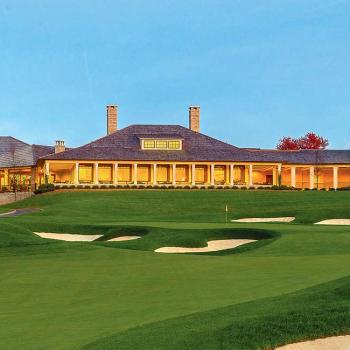For professional golfers who ever competed on the PGA Tour, Adam Schupak’s book Deane Beman: Golf’s Driving Force (2011) is a must read. Many club professionals who never played the PGA Tour will find it interesting as well, partly due to the relationship between the PGA Tour and their association, the PGA of America. I’m not going to do a full book review of it here, but will tell mostly about the two crisis the Tour had, one being during Beman’s twenty-year career as commissioner of the PGA Tour. This 365-page book is available in soft cover at amazon.com for about $23 plus shipping.
Adam Schupak writes for the weekly magazine Golfweek. (See their website golfweek.com.) Deane Beman is his first book, and he has done a good job with it. His dad, Les, told me Adam interviewed Deane for over 300 hours in order to write this book. So, it has a lot of information in it about the inner workings of the PGA Tour and some stories that had never come to light. The book states its thesis as follows: “The Inside Story of The Man Who Transformed Professional Golf into a Billion-Dollar Business.” Yes, Deane truly did. But the job certainly wasn’t all peaches and cream for him. Deane says, “I was not a commissioner that was loved…. I was respected…. I was trying to break new ground” (p. 29).
It’s one of those books I wasn’t able to put down. But then, I’m biased, since I played on both the regular Tour and Senior Tour during most of Deane’s tenure as commissioner, which was from 1974 through 1994. He was the Tour’s second commissioner, succeeding Joe Dey (pronounced “die”). Tim Finchem, a lawyer who was Deane’s deputy commissioner, has been the commissioner ever since. So, the book is not about Deane Beman’s career as a golfer, but his career as the PGA Tour’s commissioner.
The diminutive Deane Beman—who is 5 feet, 7.5 inches tall and now 75 years old—has been the only Tour commissioner who excelled at either amateur golf or professional golf, and he did both. He won two U.S. Amateur Championships, a British Amateur Championship, and four PGA Tour tournaments during his five-year career on the regular Tour. That’s a really good record. He later competed some on the Senior/Champions Tour. The best and briefest way to sum up Deane Beman’s career as a golfer may be that he was a great putter and a very determined competitor who overcame a considerable lack of distance off the tee. He put his determination to good use in his next job.
PGA Tour Commissioner Deane Beman was a true visionary. He had lots of ideas and introduced much innovation to American professional golf. He had his critics, and many of them called him “the little dictator” and/or “the czar of golf.” I think the only objection I had to him as commissioner was that he wasn’t transparent enough about Tour business for awhile and thus wasn’t providing Tour members with an annual financial statement. We didn’t even know what his salary was. But the independent businessmen directors on the board soon convinced him to do that. So, overall, I think Deane did a terrific job as commissioner of the PGA Tour. This testament to his success became increasingly evident in his waning years as commissioner, but perhaps more so in the succeeding years after he retired.
“Chapter 1: The Defining Moment,” begins with a most intriguing narrative that I didn’t know much about because I ended my full-time career on the regular Tour three months before it began to explode, and it wasn’t known much to the public. It’s about how, after Beman had been the Tour’s commissioner for nine years, the Tour’s top players tried to get him fired. Jack Nicklaus, who was by far the best player on the Tour then and still has the best record in professional golf, instigated it in March, 1983. He first went to Arnold Palmer, and they made a verbal pact to work diligently for Beman’s dismissal.
Jack and Deane had been good friends for many years, stretching back to their amateur golf days. Jack says Deane helped him win three major titles. Deane convinced Jack, after scoffing, to chart golf courses and write it in what later became known as “a yardage book.” He did it his next tournament, the 1961 U.S. Amateur, and easily won. Jack brought this innovation to the Tour, and all of us soon copied him.
(I brought my A-game to that 1961 U.S. Amateur. Yet I got dusted off the second round by a guy I had never heard of. I thought I could easily beat him, outdriving him about twenty-five yards off the tee. But he was like the gritty Deane Beman, who became one of his best friends, and his name was Jim Colbert.)
The disagreement Nicklaus, Palmer, and about a dozen other top Tour pros had with Commissioner Beman was the rather new direction in which he was taking the PGA Tour. By 1980, the PGA Tour was having limited success competing for fan support against America’s other major professional sports, primarily the National Football League (NFL), Major League Baseball (MLB), and the National Basketball Association (NBA). Even though the PGA Tour was doing pretty well in having most of its tournaments nationally televised, eighty percent of total Tour income consisted only of its tournament purses, which were augmented considerably by television proceeds.
My favorite paragraph in the book is where Schupak writes, “Early in his tenure as commissioner, Deane Beman was invited to Minneapolis for a sports business forum. Commissioners of several sports, including baseball, football, basketball and hockey were among the participants. Sitting around a table drinking coffee and Cokes, they made small talk as they waited for the event to begin. Suddenly, NFL commissioner Pete Rozelle turned to Beman and asked, ‘What are you doing here?’ Without skipping a beat, Beman said, ‘Because the PGA Tour is worth more than all of you guys.’ Rozelle’s face scrunched into a look of confusion and he responded, ‘What do you mean?’ Beman answered, ‘Well, the PGA Tour has 47 franchises–we call them tournaments–and we own them all. You don’t own any of your franchises'” (p. 265).
The next paragraph reads, “That wasn’t the only advantage Beman possessed over his counterparts in the room. Pro golf presented a squeaky-clean image that proved an invaluable asset when courting corporate America. In an era when athletes in other sports often were making headlines for the wrong reasons, the gentlemanly game of golf remained above reproach” (p. 265).
Deane believed there was a tremendous, untapped, economic potential for the PGA Tour in the corporate world. Corporate officials could play golf with the pros in the pro-ams at our tournaments. Deane wanted the Tour to market itself more, licensing its brand to corporate clients and building and owning stadium golf courses, many of which would host our tournaments.
But Nicklaus, Palmer, and a host of other big names in pro golf thought otherwise. They said the PGA Tour should restrict itself to the business of staging tournaments and not compete in the corporate world with Tour members. They complained that licensing the Tour brand and building golf courses would hurt their business in doing that. Nicklaus was adamant about it. Schupak writes that Jack said of Beman (p. 3), “I’ll do everything in my power to stop that man.,” though Schupak doesn’t reference that remark.
Nicklaus had a letter drafted listing the grievances and calling for the Tour to cease and desist these new activities. The letter had Jack’s and Arnold’s name at the top, signifying that it came by them. Jack then got a dozen top players to sign it, including Gary Player, Lee Trevino, Tom Watson, Hale Irwin, and Johnny Miller. Nicklaus then submitted it to board chairman and independent businessman director E.M. (Del) de Windt. The letter stated that if the Tour chose not to comply with these demands, the signees “will have no other choice but to take whatever action is required to protect our individual and collective rights.” Litigation?
This letter was more threatening than can be understood from these circumstances. Early in Arnold Palmer’s career he had befriended Mark McCormick, who became his agent. McCormick owned and developed International Management Group (IMG) which is now a hugely successful global sports and media business headquartered in New York City. McCormick became powerful. He had business offers in which he and Palmer could have tried to start an elite professional golf tour limited to the best, say, thirty pro golfers in the world. Of course, if that would have happened, it would have destroyed the PGA Tour. Talk about this surfaced on the Tour periodically during the 1970s and early 1980s.
I’ve always liked Jack and Barbara Nicklaus, and I have much respect for Jack. But Deane always said his goal was to promote the game of golf, and I think he stayed true to that conviction. He believed that taking the PGA Tour in this new direction would do just that. He argued that he was merely protecting and promoting the game of golf. But for me, when I consider everything that Deane was trying to do, and that which he had accomplished, I say he also was working for the entire PGA Tour membership. And that’s what the commissioner should do. Jack thought the Tour should be better represented by the top players.
When Beman received that letter in 1983, he was distraught. He thought about resigning. But he didn’t because he believed he was doing the right thing. Being a man of many ideas, thus not lacking for planned strategy, he asked player board member Jim Colbert to intervene by showing Jack Nicklaus something that turned the tide in Deane’s favor.
When Deane Beman took the job as PGA Tour commissioner, he searched Tour files and found a written agreement between the PGA Tour and the PGA of America, called “Statement of Principles,” that was drafted in late 1968. Its bylaws stated that the PGA Tour had the right to run tournaments, build and own golf courses, and participate in the selling of licensed products. Knowing this nine years later, he gave Jim Colbert a copy of this corporate charter and asked him to show it to Nicklaus. He thought it would be better for a board member, especially a player, to do this than the commissioner under the circumstances. Schupak quotes businessman and Tour board chairman Del de Windt, “Jack and Arnold were hell-bent on tossing Deane out. But everything (the Tour) was doing was agreed upon when the Tour was established as a separate entity” in early 1969 (p. 18).
Jack Nicklaus and Jim Colbert were flying together in Jack’s airplane. Jim then pulled his copy of the charter out of his briefcase and showed it to Jack. Schupak writes, “Nicklaus was rendered speechless. Finally, with an edge of suspicion creeping into his voice, he asked, ‘Who granted those privileges?’ Colbert first pointed at the [names of the] Tour’s player directors, who voted for the charter, circled the name Nicklaus and said, ‘You did’” (p. 18). WHOOPS! The Golden Bear had stepped in his own bear trap!
The book continues, “Jack saw that he was dead wrong. He was trapped by his own words in the letter and his previous actions as a board member. He realized he potentially had a serious PR problem. He had something to lose” (p. 19). Nicklaus and Colbert then discussed damage control. Nicklaus and Palmer soon met with Beman. He showed them a first Tour annual report he had just had his staff draft. Nicklaus and Palmer then withdrew from the fight.
It probably was the most well-attended players meeting ever that was soon held at the Westchester, NY, tournament–maybe all 156 of them. All the players now knew fully about the issue. Nicklaus read a prepared statement by him and Palmer. It included the words, “Our main purpose—to get more information … has been accomplished. The board has been very responsive.” Of course, there was more to it than that. Nevertheless, Jack informed the players that he and Arnold were now withdrawing their names from the letter of complaint. Jack added, “This has in no way been an affront to Deane Beman…. if Deane has one fault, it’s that he keeps a lot of things to himself.” Beman later said, “It was one of the classiest moves I’ve ever witnessed” (p. 28).
Thus, what looked like the impending firing of Deane Beman as the PGA Tour’s commissioner had been averted, and professional golf was to be the better for it.
(Next Monday: the final Part 2 of this book review. The Monday after that: “Joe Dey.”)












